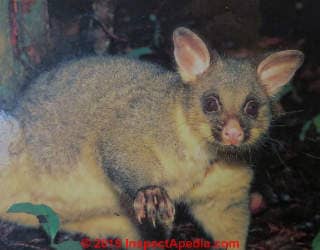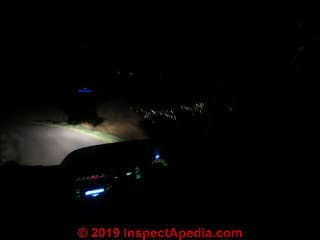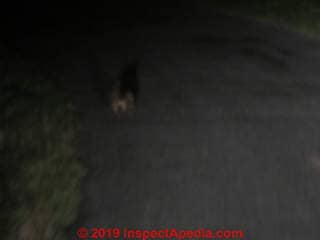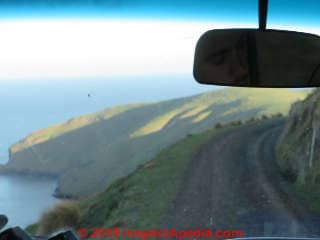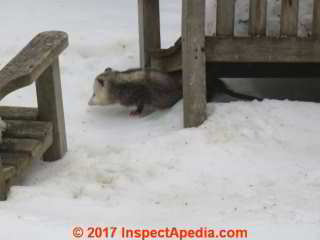 Keep Possums Out of Your Building
Keep Possums Out of Your Building
Plus: The New Zealand brushtail possum & death-defying American Possums
- POST a QUESTION or COMMENT about how to keep animal pests out of buildings
Possum removal:
This article explains how to remove Opossums from your building and how to keep them out. The author, Augie Gatto, is a San Diego California wildlife removal expert.
Our page top photo shows a Poughkeepsie possum rummaging around for food and shelter during a New York winter.
This article series discusses how to find where animals are getting into your building and how to keep them out, including bats, birds, rats, mice, and squirrels and even raccoons. This article series focuses on removing pet or other animal odors from buildings due to pet urine, pet feces, wild animal urine, or even human urine on and around buildings or on clothing and other soft materials.
InspectAPedia tolerates no conflicts of interest. We have no relationship with advertisers, products, or services discussed at this website.
- Daniel Friedman, Publisher/Editor/Author - See WHO ARE WE?
How to Get the Opossums Out of Your Attic & Keep Them Out
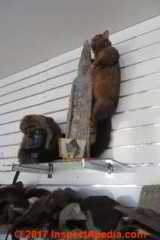 - Augie Gatto & InspectApedia editor Daniel Friedman
- Augie Gatto & InspectApedia editor Daniel Friedman
Here we describe the safe removal of Opossums (scientific name Didelphimorphia) from buildings, followed by steps to keep them from returning.
Opossums, or possums are marsupials that are native to the Americas, with a range extending from Canada through Central and South America. In North America the native Didelphimorphia is the Virginia opossum.
Brushtail possums in Australia, New Guinea, and Sulawesi are Phalangeriformes, including two species, the common brushtail possum (Trichosurus vulpecula) found in urban areas of Australia and as an invasive species in New Zealand where it is a predator on natural wildlife.
Photo: a New Zealand brushtail possum (Trichosurus vulpecula), also common in Australia, is an animal of similar name but is a different animal from North American Possums. The New Zealand possum, introduced from Australia into New Zealand by Europeans intending it to be a food and fur source, is today considered an invasive pest. In Māori the New Zealand possum is called paihamu.
[Click to enlarge any image]
In New Zealand the brushtail possum peaked at 60-70 million in the 1980s. These pests prey, among other things, on penguin eggs and bird eggs, decimating those protected populations in some areas.
The common ringtail possum (Pseudocheirus peregrinus) that is also common in Australia but is not found in New Zealand.
Beware: New Zealand Bushtail Possums Can Kill You
Watch out: It's not that the New Zealand bushtail possum (above) would attack a human directly, but swerving and veering either to avoid an animal on the road at night or even swerving to try to run over a possum deliberately can cause a fatal accident.
Photo above: a Brushtail possum in Akaroa New Zealand (2014), from a Merino Possum brand advertisement. As you'll note in our earlier photo above of a stuffed New Zealand brushtail possum standing guard over some possum-fur clothing.
New Zealanders, Kiwis, so dislike the invasive brushtail possum or merino possum that an entire industry has developed to kill them, using their fur in the production of remarkably warm and soft sweaters, scarves and gloves. And Kiwis will kill a possum on sight. By any means available as I [DF] explain here.
Photos above: You will excuse these blurry possum night-time photos when you read that in Akaroa, on a precarious cliff top track during a night drive after an excursion to observe the little blue penguins of New Zealand, our Kiwi driver, on spotting a brushtail possum in the road (photos above) swerved our van wildly towards the edge of the road (and towards the possum) in an attempt to squash the hated paihamu.
As our van, driven by a mad Kiwi possum-hater veered screaming towards the cliff edge and to an impending catastrophic 400 foot fall of our van load of tourists, end over end, to the sea below I knew that tonight the New Zealand brushtail possum was about to wreak vengeance on the those who so hated it.
A photojournalist to the death, I snapped photos in hope that the images, saved in the broken cellphone to be found with our bodies at the bottom of the tall cliff, would explain how we had died.
At the last possible second our driver recovered just in time. Still teetering wildly we wobbled our way back to the dirt track and finally, with a sigh of relief, onwards to a less terrifying highway. For the rest of that ride the passengers sat in frozen silence, deathly afraid to point out any more animal nightlife or even to ask a question that might distract the driver.
So that you can better appreciate just where we were at the moment of the night photos above, just below I include a daytime photo of the identical location.
Possums May be Difficult to Kill
Our friend N.M. is an animal lover who would never kill an opossum - at least not on purpose. When N and E, driving on a country road, struck an American Possum (American possums never ever visit New Zealand), she brought the car to a screeching halt to survey the possible possum murder.
The senior possum, leader of the possum clan, reported to us on what happened.
N., the driver, walked back along the macadam where the possum was lying in the roadway. She saw no blood, but the possum was lying there, still, but it was panting visibly. [The possum, having actually been passed-over by the auto without any injury whatsoever, was playing dead, as possums do, in hopes that the human would leave him in peace where he wanted nothing more than to rest a while on the sun-warmed pavement.]
Thinking that she needed to put the poor injured animal out of its misery, the driver looked around for a big rock or stick to do the job. There was nothing at hand. At a loss, and unable to bear leaving the little possum panting in agony, Nancy picked up the animal by its tail and swung it in an arc overhead, smashing the possum onto the pavement.
Watch out: we do not recommend this approach to possum control. It's bad for the possum and besides you might get bitten.
With N's orbiting guidance, the poor possum was smashed thus two more times, as the driver wanted to be sure it was truly killed - a mercy killing.
She tried swinging the possum a fourth time but its tail slipped from her grasp and the car-struck, thrice air-swung and smashed possum sailed through the air, then landed a few yards away in the road.
N. looked in horror at the animal as it opened one eye, stared at her, opened its other eye, rose to its little possum feet, shook itself, and snuffled off across the roadway ditch and into the pine woods where it disappeared.
That evening, the possum reporting at home that evening, began telling its wife and children ...
You won't believe what happened to me today while I was napping in the roadway!
N. on reading this description offers that the possum was exaggerating.
Other Possum Hazards to Human Health
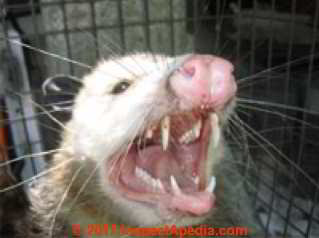 Watch out: in addition to their common role as allergens, animal feces, urine, even hair can offer serious health hazards including from various pathogens: bacteria, viruses, even possibly rabies.
Watch out: in addition to their common role as allergens, animal feces, urine, even hair can offer serious health hazards including from various pathogens: bacteria, viruses, even possibly rabies.
Watch out: also for wild animal bites, bacterial and viral hazards when entering confined spaces where invaders are or have been present.
Watch out: before sealing up a hole in a soffit or wall where opossums or other animals are entering your building, make sure the animals are not going to be trapped inside where they will be mad, frightened, hostile, even dangerous, or ultimately dead and another source of stink.
This photograph shows a possum in the attic of a California home - not really an invited guest.
Any home owner who gets regular visitors in the name of opossums on his property is well aware of the mess that these creatures can make.
[Click to enlarge any image]
Possums are definitely not free spirits to go wherever the wind takes them, they are strategic planners that will move into your house with a reason and stay with logic –especially when it comes to the necessities that they need to survive.
One of the classical reasons opossums will invade your home is to find shelter, just immediately after seeking food, an opossum attraction with which most people are familiar.
So after making sure you're not leaving food out to attract opossums, consider where they'd like to stay: when they are in the home they will love some places more than others, and one of their favorites spots is the attic.
Opossums in the attic can be a nuisance, one because of the noise and two because of the structural damage they may wreak by gnawing passageways. If you are already suffering from the mess of opossums in your attic then here are a few tips to help you flash them out.
How to Trap & Remove Opossums From Buildings
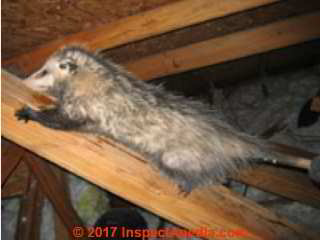 If you have skill with trapping opossums then you are good to go.
If you have skill with trapping opossums then you are good to go.
Trapping opossums and relocating them is one of the greatest ways to ensure that your attic is free of these creatures without causing much harm, but trapping is not every man’s job.
The market is flooded with all kinds of traps for this work, most of them simple to operate and set up. Once you are armed with one and you follow the right procedures then trapping an opossum should not be such a big deal, but be careful because this work is not for the faint hearted.
You will also need to take some precautions when trapping opossums, especially as it regard injury and possible death to the opossum.
Ensure that you catch the opossums live and unharmed as the contrary may have sanctions attached to it by the local laws and regulations.
Start by sealing all potential routes that these creatures may use to the attic, leaving only one exit.
This compels them into the trap, because even if they will have suspicion they will not have an alternative other than to use the only available route, leading them to the trap for eventual detention and deportation.
Hire a Professional Wildlife Removal Expert to Find a New Home for Your Possums
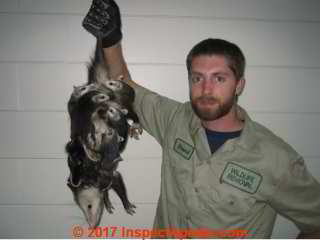 A professional wildlife removal expert is always your best option, as they already have humane traps and will relocate the animal safely.
A professional wildlife removal expert is always your best option, as they already have humane traps and will relocate the animal safely.
Leaving the task to a professional ensures a humane capture and relocation for the opossum that often has babies if she chooses shelter in your attic. A female can carry up to thirteen babies at one time!
A professional will also be able to seal up entry holes and repair any interior or exterior damage to your house that the opossum caused.
Tricks for Keeping Opossums Out of the House
Making your home and property unattractive to opossums is the first line of defense, because you don’t want to get into a fight in the first place. Free food and free shelter are the two main things that could be getting opossums obsessed with your home.
For you to force a move and ensure that opossums are not staying around for long then you will need to do away with all potential shelters they may find on your property and also eliminate the freebies that they may have been enjoying without paying a single tax.
Once these are gone, possums are surely going to rethink their options with the possibility of moving top on the priorities. These creatures definitely do not want to starve or stay in the cold until they starve or die.
Sealing any potential routes that opossums may be using into your property and landing onto the attic is also a great deal when it comes to flushing them out. They are not going to amass armies at your door to break down all defenses around your home and break in; they will definitely look for weak spots that they can capitalize on to gain easy access to the attic.
Once all of these loopholes are sealed, they will move around trying to look for entries, but if their attempts do not yield anything then they are surely going to move elsewhere.
Opossums are also very much aware of the danger posed by their predators, and they are keen not to come into contact with such animals for the fear of their lie. You are actually not required to go hunting for countless enemies to scare these creatures away, just a few tricks will do.
Having some ammonia or dog urine splashed around the places where they are nesting will alert their sense, and knowing that danger lurks around these creatures will surely not continue hiding themselves up in your attic. They will ready themselves for the flight before they are attacked.
Animal & Wildlife Removal Resources
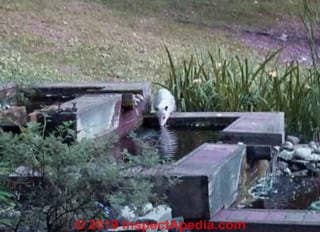 Photo: Possum at a Poughkeepsie, New York home, making its regular visit to a small pond where it takes a drink at twilight each evening. Possums like many animals, develop regular routes through their home territory.
Photo: Possum at a Poughkeepsie, New York home, making its regular visit to a small pond where it takes a drink at twilight each evening. Possums like many animals, develop regular routes through their home territory.
- Augie Gatto (a contributing author for this article), San Diego, CA 92117 USA, is a wildlife removal expert in California. Email: info@wildliferemovalusa.com.
- WILDLIFE REMOVAL USA, serving locations in the United States, provides a map giving local wildlife removal expert contact telephone numbers; Email: info@wildliferemovalusa.com
Australia Wildlife Control
- NatureCall Environmental, Domestic & Household Wildlife Remover in Australia, 1/52 Newheath Drive Arundel, QLD 4214, Tel: 1300 319 954, Website: http://www.naturecall.com.au/industries/domestic-andhousehold/ Email: info@naturecall.com.au
Canada Wildlife Control
- Canada Wildlife Removal Professionals, Directory of experts in Toronto, Montreal, Vancouver, Calgary, Edmonton, Quebec City, Winnipeg, Ontario, Ottawa, Alberta: Website: http://www.wildlife-removal.com/state/Canada.htm
New Zealand Wildlife Control
- Kiwicare Corporation, 225 Maces Rd, Bromley, Christchurch 8062, New Zealand Pest Control, Tel: +64 3-389 0778
- Rentokil Hillsborough, Christchurch, New Zealand pest control, Tel: +64 3-373 6100
- Rentokil, Wildlife Control, Australia, Tel: 1300 307 938, Website: http://www.rentokil.com.au/other-wildlife/
- Rentokil Pest Control Wellington New Zealand, 56 Fitzherbert St, Petone, Lower Hutt 5012, New Zealand, Tel: +64 4-568 1220
- Rentokil Pest Contro89 Carbine Rd, Mount Wellington, Auckland 1060, New Zealand, Tel: +64 9-573 4810 or +64 9-573 4810
- Rentokil Pest Control Hamilton, New Zealand, Tel: +64 3-332 1962
U.K. Wildlife Control
- Humane Wildlife Solutions, 18 Weensland Park, Hawick TD9 9RP, UK, Tel: +44 7771 361226
- Wildlife Control Services, 112 Caernarvon Rd, Cheltenham GL51 3JR, UK, Tel: +44 1242 706099
Question: use of peppermint oil and ammonia to repel animal poopers and pests
(Sept 23, 2012) Anonymous said:
I have heard that peppermint smell repels mice and squirrels. Is that so?
Reply:
Good idea Anonymous. Peppermint is better than trying to scatter mothballs apart as using mothballs for animal repellant is an illegal application and can cause other building odor or health problems.
A number of animal repellant products do indeed contain peppermint oil, such as some deer and cat repellants. ther mixtures for similar applications mix oils of peppermint, geranium, sage, lavender, eucalyptus, lemongrass etc.
There are other specific animal repellent sprays and products sold at home and garden suppliers, often targeted to specific animals: coyote urine, for example. I've also tried pouring a bit of ammonia (or bleach but never BOTH at once) onto an area on a walkway or stair where a cat kept urinating.
Outdoors where our neighbour's cat had decided that our stone walkway was a nicer toilet than its own yard we had such an accumulation of cat poop that besides cleaning up that mess we needed to encourage Cheeto to find a different relief site. After cleaning up the mess we poured household ammonia around the poop area. That worked.
...
Continue reading at ANIMAL ENTRY POINTS in BUILDINGS or select a topic from the closely-related articles below, or see the complete ARTICLE INDEX.
Or see these
Recommended Articles
- ANIMAL DAMAGE to BUILDINGS - home
- ANIMAL ENTRY POINTS in BUILDINGS
- ANIMAL NOISES in BUILDINGS
- ANIMAL or URINE ODOR SOURCE DETECTION
- BIRD DROPPING STAIN REMOVAL
- BIOLOGICAL POLLUTANTS
- BLACK STAINS from ANIMALS
Suggested citation for this web page
OPOSSUM REMOVAL from BUILDINGS at InspectApedia.com - online encyclopedia of building & environmental inspection, testing, diagnosis, repair, & problem prevention advice.
Or see this
INDEX to RELATED ARTICLES: ARTICLE INDEX to ANIMAL PESTS, ALLERGENS, HAZARDS
Or use the SEARCH BOX found below to Ask a Question or Search InspectApedia
Ask a Question or Search InspectApedia
Try the search box just below, or if you prefer, post a question or comment in the Comments box below and we will respond promptly.
Search the InspectApedia website
Note: appearance of your Comment below may be delayed: if your comment contains an image, photograph, web link, or text that looks to the software as if it might be a web link, your posting will appear after it has been approved by a moderator. Apologies for the delay.
Only one image can be added per comment but you can post as many comments, and therefore images, as you like.
You will not receive a notification when a response to your question has been posted.
Please bookmark this page to make it easy for you to check back for our response.
IF above you see "Comment Form is loading comments..." then COMMENT BOX - countable.ca / bawkbox.com IS NOT WORKING.
In any case you are welcome to send an email directly to us at InspectApedia.com at editor@inspectApedia.com
We'll reply to you directly. Please help us help you by noting, in your email, the URL of the InspectApedia page where you wanted to comment.
Citations & References
In addition to any citations in the article above, a full list is available on request.
- Wikipedia Web: https://www.wikipedia.org/ at https://en.wikipedia.org/wiki/Possum, retrieved 2017/04/05, provided background information about some topics discussed at this website provided this citation is also found in the same article along with a " retrieved on" date. NOTE: because Wikipedia entries are fluid and can be amended in real time, we cite the retrieval date of Wikipedia citations and we do not assert that the information found there is necessarily authoritative.
- In addition to citations & references found in this article, see the research citations given at the end of the related articles found at our suggested
CONTINUE READING or RECOMMENDED ARTICLES.
- Carson, Dunlop & Associates Ltd., 120 Carlton Street Suite 407, Toronto ON M5A 4K2. Tel: (416) 964-9415 1-800-268-7070 Email: info@carsondunlop.com. Alan Carson is a past president of ASHI, the American Society of Home Inspectors.
Thanks to Alan Carson and Bob Dunlop, for permission for InspectAPedia to use text excerpts from The HOME REFERENCE BOOK - the Encyclopedia of Homes and to use illustrations from The ILLUSTRATED HOME .
Carson Dunlop Associates provides extensive home inspection education and report writing material. In gratitude we provide links to tsome Carson Dunlop Associates products and services.


